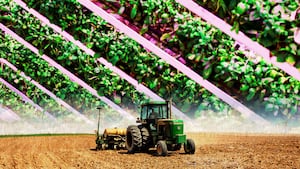“I pull my hair out and wish for a time machine.” Patty Lovera could be talking about a million different things in the world right now, but in this case, she’s referring to something near and dear to her profession: what it means to label food as “organic.” The policy director for the Organic Farmers Association (OFA) told the Daily Beast that if it were up to her, she would ride that time machine decades into the past and urge the people who wrote the Organic Foods Production Act in 1990 to be a little more clear about what they meant. “Because we bicker about this stuff.”
Officially, the Environmental Protection Agency defines organic food as: “Food grown and processed using no synthetic fertilizer or pesticides.” Products emblazoned with the U.S. Department of Agriculture’s organic seal follow these guidelines. And this system has proven to be financially lucrative. As of 2019, there were 22,687 organic farms in the U.S. In 2020 alone, Americans spent a total of $56.4 billion on organic produce, up from $50 billion the previous year.
“Organic is a marketing program for many of our farmers,” said Lovera. “It is a way of life.” And it has become a way of life for consumers, too. A 2021 study found that most customers perceive organic food as healthier than conventionally grown produce—even if they don’t actually know what “organic” really means.
Pro-organic lobbying groups are taking advantage of this confusion, employing the label to cudgel against new types of food production technologies that could enjoy a massive boost if included. Foods altered by biotechnology—i.e. GMOs—are unsurprisingly excluded from taking part in the organic farming market, despite the fact that they could be critical to helping us feed the world as climate changes, population increases, and disappearing arable land threatens to decimate some of our most important farming sectors.
Lobbying groups like The Non-GMO Project—a pro-organic, anti-GMO organization—have dedicated their time and funding to stopping GMOs from accessing the benefits of the organic food label, starting with the organization’s logo featuring an idyllic butterfly landing on a plant. Seeing this illustration on a box of crackers or a piece of fruit is meant to assure the buyer that their food is “natural” (an unregulated and vague term frequently used in greenwashing campaigns).
More aggressively, the organization’s website claims that GMOs are not safe because of the absence of credible studies. A 2016 National Academy of Sciences report virtually disproves that claim, stating that the committee behind the report examined epidemiological datasets from 1990 (the widespread introduction of GMO foods in both the US and Canada) onwards and no patterns of specific health concerns were determined. An additional 280 other independent scientific and technical institutes agreed. (The Non-GMO Project declined The Daily Beast’s request for a comment.)
One survey out of Rutgers University showed that 54 percent of American consumers know little to nothing of GMOs, while a solid 25 percent had never heard of GMOs at all. A 2019 report by the Information Technology & Innovation Foundation concluded that The Non-GMO Project’s marketing material is misleading and inaccurate, interfering with the consumer’s ability to make an informed and wise purchasing decision.

The "bioengineered" label issued by the USDA.
USDAIt’s no wonder that in the absence of an informed public, organic food groups have found it easy to build GMOs up as a scary boogey-man, even to policy makers. As of Jan. 1, 2022, any company selling food that “is or may be” bioengineered must brandish a federally designed logo (a plant with star growing in a sunny, rural scene). Though inspired by the wildly successful marketing campaign of the organic food label, the USDA chose to veer away from the term “GMO” and instead champion “bioengineered,” to disassociate from previous negative connotations. This decision proved to be controversial, as The Center for Food Safety, Natural Grocers, and other plaintiffs filed a motion in October of 2020 claiming that the prohibition of the terms GMO and genetic engineering is confusing for customers.
However, genetic modification has already been allowed in USDA organic certified crops for decades. In a method called mutagenesis, seeds are flooded with either radiation or chemicals to make random DNA changes. Around 95 percent of seeds grown for organic agriculture are meant for conventional growth, producing depleted yields and less than robust crops. Mutagenesis is necessary to support an organic farmer’s overhead, aiding seeds that were not designed to grow in an atmosphere without fertilizer, pesticides, or herbicides. Whether organic farmers are aware their seeds are bioengineered is unclear, but what is clear is the economic viability of these altered seeds under the organic banner.
Emma Kovak, a senior food and agriculture analyst with The Breakthrough Institute in Oakland, told The Daily Beast that biotechnology simply means using a living organism to make something, specifically by making “targeted changes in genes.” Despite the negative press, biotechnology has the potential to generate healthier alternatives for widely used cooking ingredients like soybeans or olive oil. It can also potentially decrease food waste, increase crop resilience, and adapt crops to grow in climate-friendly farming methods that substantially decrease long-term soil erosion.

Packages of Impossible Foods burgers and Beyond Meat made from plant-based substitutes for meat products.
Angela Weiss/GettyGMOs aren’t just a potential way to keep us fed in the future—they might also simply help us enjoy our food. Bioengineered products encompass a wide range of popular foods, including very trendy ones these days—like plant-based meats. In an effort to combat the massive negative impacts associated with animal agriculture, Impossible Foods sells various meat-alternatives (think burgers, chicken nuggets, and pork) thanks to the help of heme, a naturally occurring molecule in the muscle tissue of cows, chickens and pigs, provides that familiar taste and sensory experience associated with eating meat.
Michael Eisen, at geneticist the University of California, Berkeley and a consultant for Impossible Foods, told The Daily Beast that heme can also be found in the roots of soybeans, providing a vegetable-based alternative that provides the same meaty flavor and sensory experience. Impossible Foods scientists, said Eisin, were able to introduce the molecule into a yeast cell and grow the isolated heme in a lab. That means the heme is grown by a GMO.
In effect, Impossible Foods and its competitors are using biotechnology to fill the void of vegan fast food.
Despite these innovative potentials, the organic community rejects any possibility of biotechnology entering their fold. According to Lovera, farmers have expressed concerns to her about the perceived lack of rigor given to inspecting the farms using biotechnology altered seeds. Citing pervasive chemical drift, or pesticides unknowingly moved through air currents, Lovera suggested that neighboring organic crops and soil would be contaminated by farmers exceeding the usual amounts of pesticides due to their bioengineered crops, leading to an organic farmer’s financial ruin.

Emma Kovak.
Courtesy The Breakthrough InstituteKovak disagreed, citing the unnecessary expenses related to spraying unnecessary pesticides on already insect-resistant genetically modified crops. Similarly, she pushed pushed back on the notion that organic farming is the only safe alternative. “People often assume [organic farming is] the most environmentally friendly way of farming,” she said. “It’s really based on an idea of nature rather than prioritizing using the most environmentally friendly practices.”
Kovak has a point. Studies run by The Swedish University of Agricultural Sciences demonstrate that organic farming can lead to excessive land use and smaller produce yields. Zero pesticide use might be healthier for soil and surrounding environments, but it also requires farmers to put more work into the land to produce equivalent yields as conventionally grown systems. Excessive land use can lead to greater amounts of carbon released into the atmosphere—something we especially want to avoid these days.
Some more resistance to widening the organic label might stem from the history of farming, and how the introduction of new technologies creates upheavals that force generations of smaller producers out of business. Even now, we’re seeing small farms closing up, and their land increasingly absorbed into large farming companies. A sobering 20-year analysis by Statista showed that as farm sizes (acreage per farm) increased in the U.S., the number of individual farms decreased. In 2019, 81.5 percent of all operating farms earned less than $100,000 annually, according to the USDA. It’s extremely difficult for a family farm to sustain itself anymore. Opening up the organic label to emerging farm approaches like bioengineered crops could very well accelerate this trend.
Maybe it’s just a matter of time. In April of 2021, Oregon Congressman Peter DeFazio introduced the Continued Improvement and Accountability in Organic Standards Act, a bipartisan bill meant to improve federal oversight of organic processes and standards. The bill hopes to finally update outdated language and open up the organic certification process to a more diverse field of food production. Hopefully, this includes laying out a path for bioengineering, and thus rapid growth in sustainability potential, within the organic market.
For many advocates of new farming innovations, this is better late than never. Climate change is forcing humanity to alter its food to thrive in an increasingly unpredictable and uninhabitable environment. It is to the benefit of the organic community to read the organic tea leaves and form a united front with new agriculture technologies if the food industry plans to keep everyone fed.
Correction 2/16/21: The original version of this story had a misquote from Novak, which has now been corrected. We regret the error.







